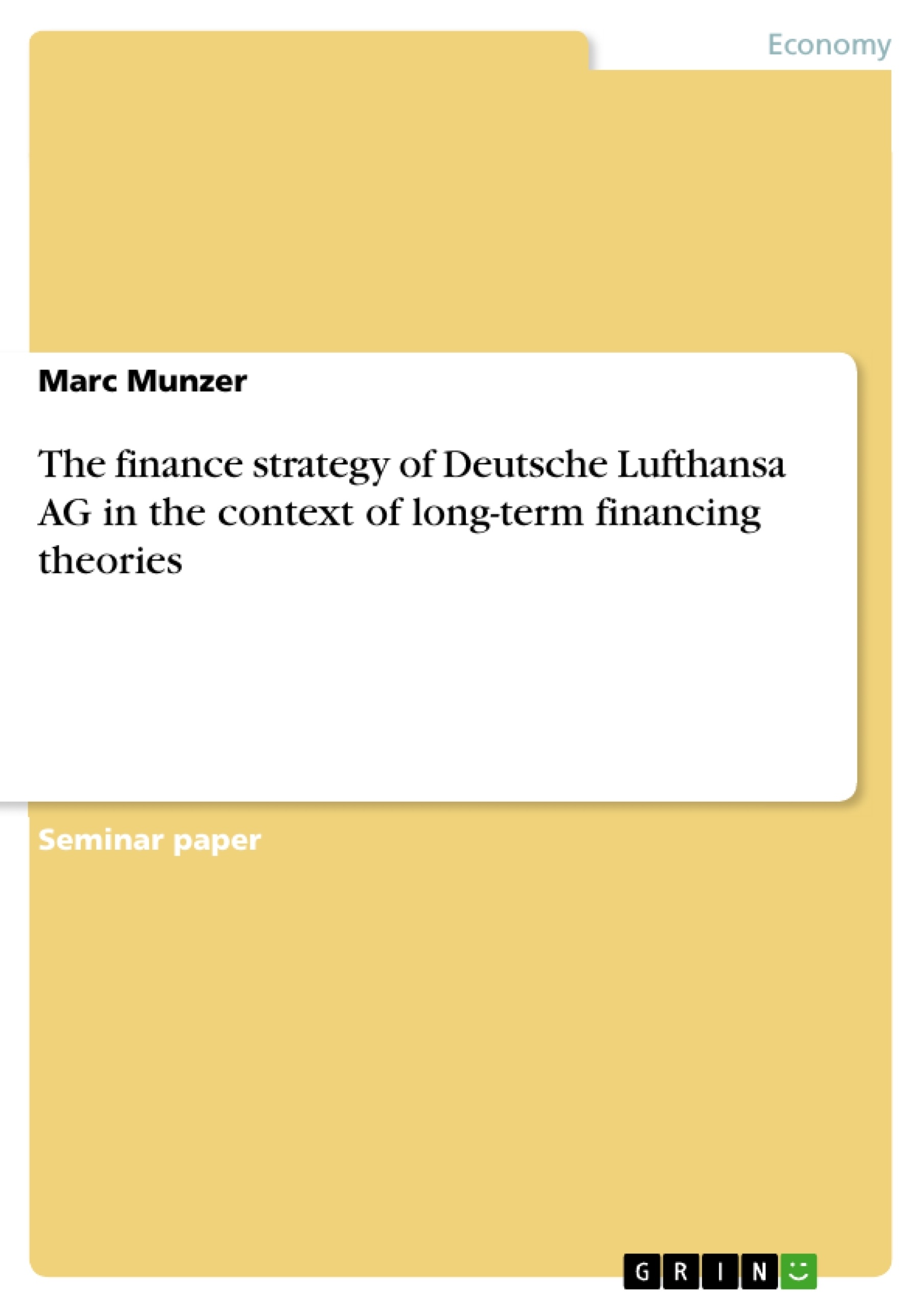Excerpt
Table of Contents
List of Abbreviations
List of Figures and Tables
Introduction
Brief company profile
Finance strategy
Capital Structure
Capital Structure Theories
Conclusion
Appendix
References
List of Abbreviations
illustration not visible in this excerpt
List of Figures and Tables
Figure 1 Lufthansa Group Structure
Figure 2 Information about the Capital Structure
Figure 3 Investment-grade Ratings
Figure 4 Effect of Proposed Right Issue on Lufthansa’s Cost of Capital
Figure 5 The WACC and its influencing Factors
Table 1 Equity Ratio and Gearing
Table 2 Net Indebtedness of Lufthansa
Table 3 Lufthansa Bonds
Introduction
Long-term financing and therefore the question of capital structure is essential for all kinds of business. Every organisation should take into account financing patterns in order to set up a target capital structure, which reduces the cost of capital. The optimal capital structure tends to rely on a variety of factors, such as industry, ownership structure, personal attitude to risk, nationality, and dimension of asymmetric information. Due to the significance, many theories regarding these matters have been developed with sometimes more contradictory explanations.
This paper deals with the long-term financing patterns of the Deutsche Lufthansa AG. Firstly, the work gives a brief company’s profile and investigates its capital structure. Further, the composition of shareholders’ equity and debts are examined in order to critically asses Lufthansa’s rationale for its financing mix. Finally, referred on relevant long-term financing theories, the work summarizes the findings.
Brief company profile
Deutsche Lufthansa AG (henceforth Lufthansa) was founded on January 6, 1926 and has since then become a worldwide operating aviation company with currently 108,123 employees and annual revenues of €24.9 billons in 2008. Its headquarters are in Cologne, Germany (Lufthansa, 2008a). The Lufthansa Group is composed of five segments: passenger transportation; logistics; maintenance, repair and overhaul (MRO); information technology (IT) services, and airline catering (Appendix I). Lufthansa is the biggest single operating firm and therefore operates as the parent company of the group. As usual in Germany, the Group divides its structures in Supervisory and Executive Board. The company’s core functions are compartmentalised by the three members, the CEO, the CFO and the Chief Officer for Aviation Services and Human Resources, which present the Executive Board. The Group has over 400 subsidiaries and associated firms. The network of operations in 103 countries, mainly in Europe, North America and Asia, helps Lufthansa to attain a leading position in its respective segments (Lufthansa, 2009a). According to Datamonitor (2008a), the group, with its 529 aircrafts, has the second largest passenger airline fleet. With 62.9 million passengers carried in 2007, Lufthansa is the largest airline in Europe and the fifth worldwide. With a market share of 30 per cent LSG Lufthansa is the market leader in airline catering. Lufthansa Technik, with a 15 per cent market share, also has a strong position in global airport services compared to its competitors. The business segments IT Services, Catering and MRO support and strengthen the major parts Passenger Transportation and Logistics. The following figure illustrates the segment proportion of the Group’s total annual revenue of €24.9 billion (Lufthansa, 2008a).
illustration not visible in this excerpt
Figure 1 - External revenue share of business segments
Source: Lufthansa, 2008a, 52
In the following section this paper is going to consider Lufthansa’s financial strategy in order to analyse its long-term financing patterns. Furthermore, the work will critically assess the findings with long-term financing theories.
Finance strategy
illustration not visible in this excerpt
Capital Structure
A high degree of creditworthiness is a result of a permanent strong capital structure. Therefore, Lufthansa not only sets aside retained earnings, but defines a long-term equity target of 30 per cent. Since 2004, the company outsources pension obligations to raise the ratio (Lufthansa, 2009b).
The consolidated balance sheet was €22.4bn for the financial year 2008. Non-current assets augmented by €899m to €15.0bn contrary to the current assets which decreased by €811m to €7.4bn. On the liabilities side, the shareholder’s funds increased by €19m to €6.9bn and the current liabilities by €320m to €8.6bn. Non-current liabilities and provisions declined by €251m to €6.9bn. The company’s equity ratio stayed constant at 30.9 per cent and hit the target of 30 per cent. However, the return on equity decreased to 8.8 per cent due to fewer earnings. The figures below show the balance sheet structure of Lufthansa in more detail (Lufthansa, 2008a).
illustration not visible in this excerpt
Figure 2 - Information about the Capital Structure
Source: Lufthansa, 2008a
Lufthansa has a target band of between 40 and 60 per cent for its gearing (net debt to equity ratio). Notice that since 2004 the company includes pension provisions to the net indebtedness. The table below shows that since 2004 (92.5 %) gearing decreased substantially and that only the last two years were below the target corridor (Morell, 2007). The higher the gearing, the more risky and vulnerable the firm is declared, because in downturns the firm has to continue to service the debt (Investopedia, 2009). According to Analysts of Merrill Lynch (Bor et al., 2004, 6), Lufthansa’s net gearing is “well below industry average” (Appendix II). According to Harris and Raviv (1991), firms within the same industry have more similar leverage ratio than within different industries. Moreover, they claim that the airline industry has a consistently high leverage ratio.
illustration not visible in this excerpt
Table 1 – Equity ratio and gearing
Source: Lufthansa, 2009b
[...]
- Quote paper
- Marc Munzer (Author), 2009, The finance strategy of Deutsche Lufthansa AG in the context of long-term financing theories, Munich, GRIN Verlag, https://www.grin.com/document/133548
Publish now - it's free






















Comments